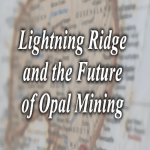 Regular readers already know that while we love fine jewelry of every description, at Anderson-Beattie we have a special affection for opals. That means we also have a special affinity for October ... and it has nothing to do with Pumpkin Spice.
October is the month of opals. opal is October's original birthstone as laid out by the 1870 poem published by Tiffany & Co. The verse for October reads:
October‘s child is born for woe,
And life’s vicissitudes must know,
But lay an opal on her breast,
And hope will lull those woes to rest.
Later, Tourmaline was added as a second birthstone for October. Some said this was added to expand the birthstones to reflect more of Nature's beauty. Others, however, say the second stone was added to October (a few other months also had a second stone added) in order to give a more affordable option to people who wanted birthstone jewelry.
Opals have become some of the most highly sought after gemstones in the world of fine jewelry. The interest is a welcome trend for opal jewelers as well as Australia, where opals are mined. At the same time, people with an interest in preservation as well as supporting local communities have lobbied to ensure the exploration and mining of these precious gemstones remains something that helps, rather than hinders, Australia.
Regular readers already know that while we love fine jewelry of every description, at Anderson-Beattie we have a special affection for opals. That means we also have a special affinity for October ... and it has nothing to do with Pumpkin Spice.
October is the month of opals. opal is October's original birthstone as laid out by the 1870 poem published by Tiffany & Co. The verse for October reads:
October‘s child is born for woe,
And life’s vicissitudes must know,
But lay an opal on her breast,
And hope will lull those woes to rest.
Later, Tourmaline was added as a second birthstone for October. Some said this was added to expand the birthstones to reflect more of Nature's beauty. Others, however, say the second stone was added to October (a few other months also had a second stone added) in order to give a more affordable option to people who wanted birthstone jewelry.
Opals have become some of the most highly sought after gemstones in the world of fine jewelry. The interest is a welcome trend for opal jewelers as well as Australia, where opals are mined. At the same time, people with an interest in preservation as well as supporting local communities have lobbied to ensure the exploration and mining of these precious gemstones remains something that helps, rather than hinders, Australia.
How Opals Are Mined
Opal is unique in many ways but perhaps its most unique characteristic is in how it is formed and how it can be mined. Unlike many other gemstones, various forms of opal can be mined quite safely and economically even by a lone, independent miner. The process of how opal is mined is old, but simple. Essentially a hole is dug in an area believed to hold an opal deposit. As explorers probe and explore an area, they branch out from the original shaft they dug in order to look for seams of opal deposits. Lightning Ridge, an area in New South Wales, Australia, has more than 60 'fields' which have yielded nearly all of the Black opals found in in today's market. It has also become the place where the future of opal mining may change forever.Lightning Ridge
You can't learn about opal mining without learning a whole lot about Lightning Ridge. Lightning Ridge is technically a small town in NSW Australia. While the town itself is small geographically, its impact on the opal market is huge. It is the undisputed and highly respected epicenter when it comes to Black opals as well as other opal gemstones. Opals aren't the only thing found in Lightning Ridge's hot and arid climate. It is also a well known area in the world of paleontology. Paleontologists have found fossils of ancient mammals as well as plenty of aquatic plants and other animal. This is due in large part to the fact that the sandstone that makes up the ridge today was once the bottom of a small inland sea. Some of the fossils found in the area date as far back as 110 million years ago. Even more interesting, many of these fossils have been opalised and found during the opal mining process. Opalized Ammonite (Reddit)
Opalized Ammonite (Reddit)
The Strength of People
Lightning Ridge has always been a town set apart. The high stakes opal game has always attracted a special kind of person. It takes a sense of adventure, a willingness to risk it all and, of course, strength to defend what's yours. Areas of lands are staked out, plots are registered and people simply get to work. Some people begin the day without a spare penny to their name and by the time the sun goes down, they're rich. Of course, that doesn't happen to everyone and there's plenty of poverty in the area. This has caused some unique challenges over the years. Challenges which have needed to be met by locals. One such issue was how to deal with the dead. Over the years, people lived their lives out looking for treasure or simply disengaging from mainstream society by settling in Lightning Ridge. Many of them die penniless and without any local familial ties. Add to that the fact that Lightning Ridge is an outback town with access only by unpaved roads adn with an intimidating wild kangaroo population nearby, it's no wonder undertakers haven't exactly flocked to serve the area. That's why, more than two decades ago, locals decided they would take the matter into their own hands. For the past 20 years, local miners have steeped up as amateur undertakers. Here, the men and women who work, toiled, celebrated and commiserated with their fellow miners are often the same ones who ready them for their final resting place. While a bit morbid, it's the perfect example for how strong, creative, tenacious and resourceful you need to be if you were going to make it in Lightning Ridge. It also provides a clear illustration of the compassion and sense of community these miners have for each other.The Future of Opal Mining
While the people of Lightning Ridge were originally attracted to the area thanks to its reputation for opportunity, its future in terms of opal mining has recently come into question. In the 1990s there was a boom in the opal market with people quite literally flocking to the area in order to find their fortune. As with any natural commodity, however, things are changing for the opal market in Lightning Ridge. While the 1990s saw a windfall for miners, the national Australian government was able to see that it was a resource which needed to be protected. That was the motivation for exacting the Mining Act of 1992 which addressed a host of issues already facing the industry as well as looking forward to protect the resource, the industry and the land. This forward thinking resulted in extra protections being in place before the newest area of opal exploration - called OPA 4 - was opened. In order for people to gain access to mining in this new area, they must agree to conditions set out in a part of that 1992 Mining Act. Miners must agree to the following conditions:- Ensure the mineral bearing capacity of the license area is adequately researched.
- Prevent, minimize, and/or offset adverse environmental impacts.
- Ensure the area disturbed by prospecting activities is appropriately rehabilitated.



